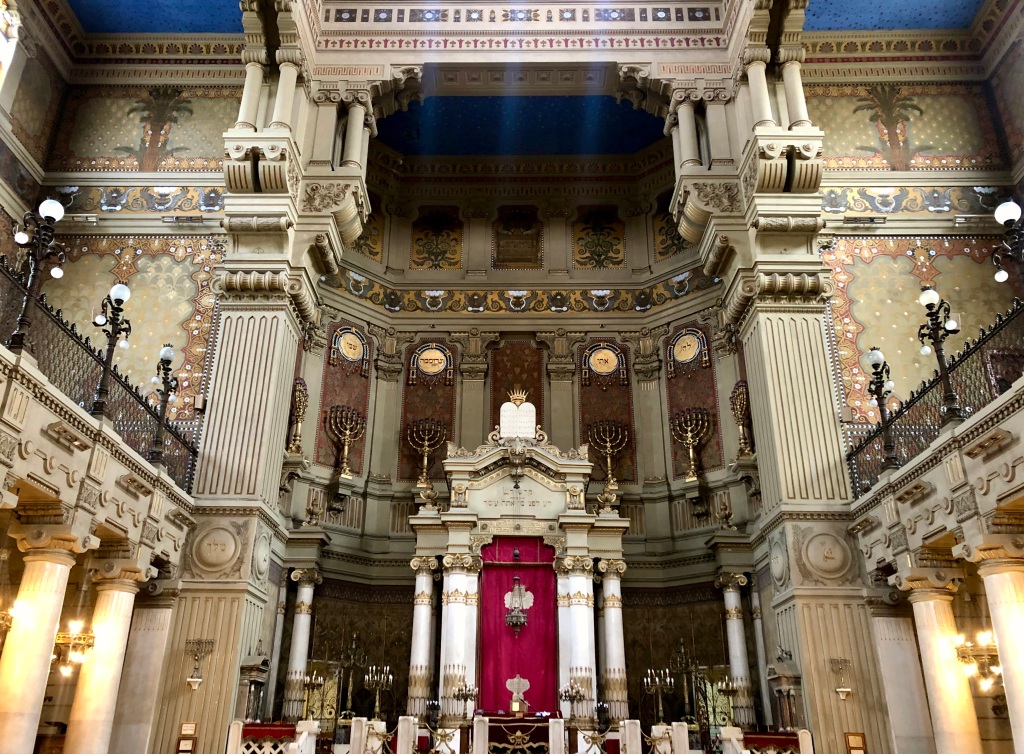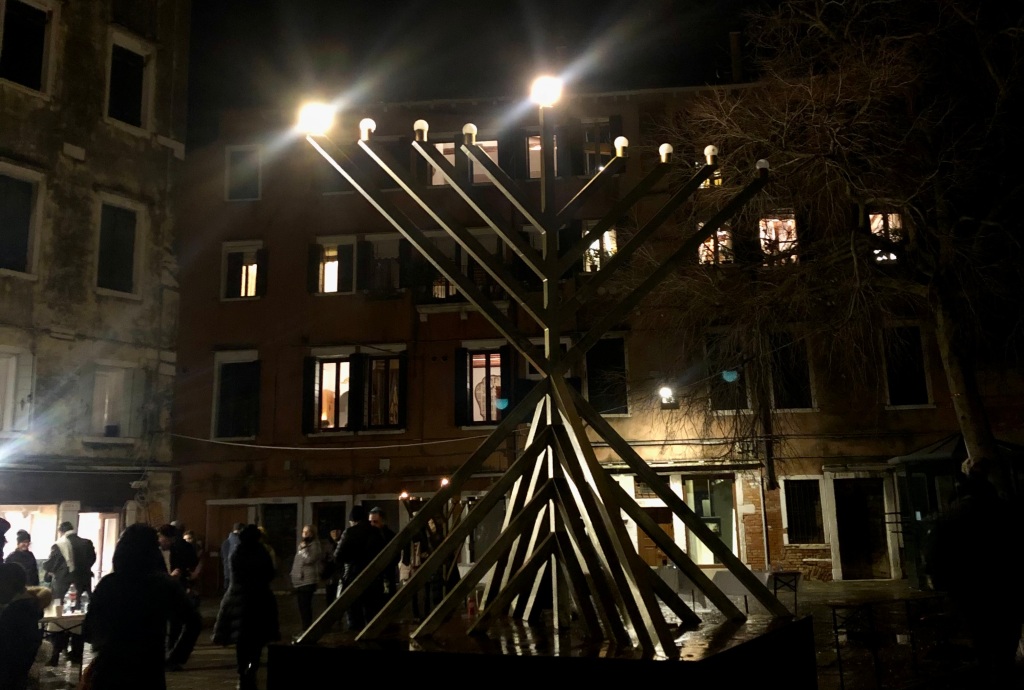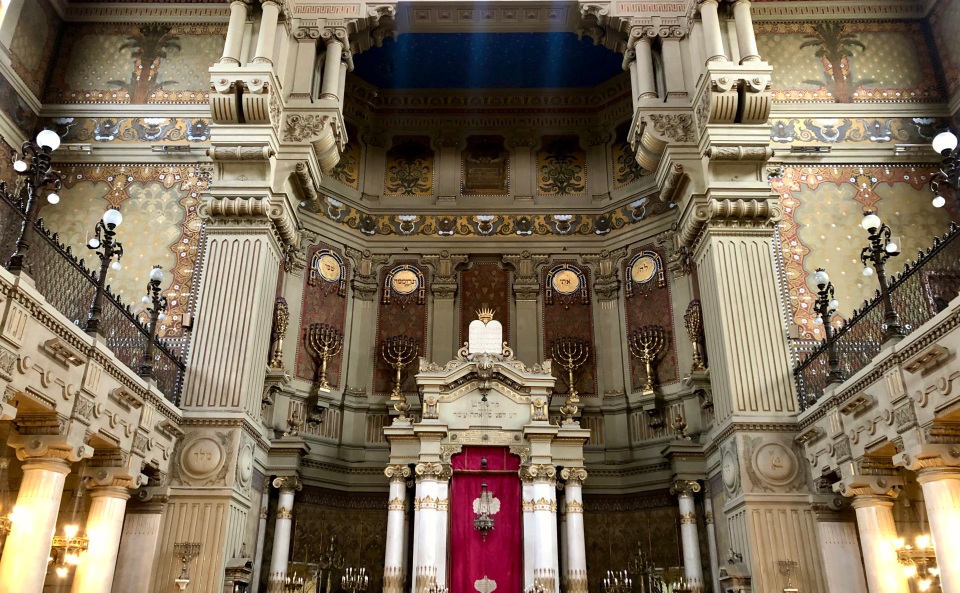Happy Hanukkah and Shabbat Shalom! If you’re the Torah-studying sort, you might be settling in to read this weeks haftarah, in which Zechariah prophesies the rebuilding of the Temple after its first destruction. We read it during Hanukkah to remind ourselves of the anguish our ancestors would have felt at that Second Temple’s desecration by King Antiochus’s idols—the anguish that would inspire the Maccabees to revolt. By pure coincidence, we read that exact same haftarah a second time each year in the summer month of Sivan, paired with the torah portion Beha’alotecha, which I only know because I read it at my bat mitzvah.
I’d love to say it’s some sort of fate, then, that I love Hanukkah so much—or at least that I took my bat mitzvah study to heart—but the honest truth is that reciting the construction parameters for the new menorah made little impression on thirteen-year-old me. It’s more likely my love for the holiday came from the early nights, the gatherings with family, and the lighting of candles in the dark.

I’m sure the presents didn’t hurt, either. Nor did the opportunity for arts and crafts. | Courtesy of David Glazer © 2002
This year, I spent the first few nights of Hanukkah in Italy.1 That might seem like a surprising place for our family’s holiday festivities, but as we soon learned, it was a more fitting choice than we’d even imagined.
Today, Rome’s Jewish population is small but thriving, and the site of the former Jewish ghetto has been transformed into a vibrant square that echoes with the shouts and laughter of the students at the Hebrew school and the chatter of diners at the multitude of kosher restaurants. It hasn’t always been this cheerful—the community faced centuries of oppression before the ghetto gates were finally opened in the 19th century—but the Bene Roma are, if anything, resilient.

The Great Synagogue of the ghetto is a beautiful work of architecture, though it’s much younger than the community. It was built in 1904 after the old synagogue and most of the rest of the ghetto were razed and rebuilt in the name of urban renewal. | Image © Rebecca Glazer 2021
Many of us who receive a Jewish education in the United States are taught (or simply assume) that Jewish communities only spread outside of the Holy Land with the Diaspora—the mass emigration and dispersal of Jewish refugees after the destruction of the Second Temple in 70 CE. But the Bene Roma had already been in Rome for over two centuries by the time of the Diaspora—and how they came to be there has everything to do with Hanukkah.

A map of the old ghetto, pre-renewal. Note how many churches surround what is today only four square blocks. One was placed outside each gate so that it would be the first thing a Jewish person encountered if they left. | Photo © Rebecca Glazer 2021
In 161 BCE, the Maccabees realized they needed help. Antiochus IV had recently seized the throne of the Seleucid Empire with dreams of reconquering all the former territories of Alexander the Great, and after an embarrassing defeat in Egypt by the Ptolemaic Kingdom’s new ally—the Roman Republic—he set his armies to capturing Jerusalem. Judea had fallen to Ptolemy when Alexander’s Empire had been divided among his successors and had functioned semi-autonomously since then, but now Antiochus cracked down on Jewish religious expression. He forbade circumcision and the possession of the Torah and, perhaps worst of all, erected a statue of Zeus in the Holy Temple.
Many of us know the story of the Maccabean revolts—how the four Maccabee brothers led a resistance movement from the hills above Jerusalem, launching guerrilla attacks and pretending to play with small spinning tops in their caves to hide their battle plans. But I certainly had never learned that the Maccabees looked outward for military aid. It’s true, though—and it’s with the diplomatic delegation of Shimon Ha-Maccabee, sent to procure an alliance with the Roman Senate, that the Jewish community of Rome finds its birth.
The evidence lies not just in the oral histories of the community, but in a network of caverns outside of the city. When the delegation arrived in Rome, one of the first things they needed was a place to bury their dead. Forbidden from utilizing Rome’s existing catacombs, the Jewish delegation dug their own, where they would continue to hold their burials for over a millennium.

You can’t say this isn’t a Jewish grave marker. Note the lulav and etrog to the right of the menorah, and to the left, what might be a shofar. | Image © Rebecca Glazer 2021
We met up with Micaela Pavoncello of Jewish Roma Tours, who took us deep into the catacombs and shared with us the story of the community’s origins. We saw how the grave markers changed from Greek to Latin as the first few generations of Roman Jews assimilated linguistically, but the markers never lost the symbol that most deeply represented their community, that had driven them to Rome in the first place: the menorah.


By a bitter irony, it would be the Roman army itself that would invade Jerusalem a century later, establishing Judaea first as a protectorate and then as a kingdom under Herod after the assassination of Julius Caesar. Another hundred years would pass before the Jewish resistance would grow strong enough to provoke full-scale war—in 66 CE, while Nero still fiddled over the ashes of Rome, the so-called Great Revolt began which would culminate in 70 with the destruction of the Temple.

The placard beside the Arch of Titus explains that it was dedicated to the emperor “to celebrate his triumph in the Jewish War of 70 AD.” Its description continues, “On the walls two large panels illustrate the triumph over Jerusalem: the famous seven-armed candelabrum (menorah) stands out well.” | Image © Rebecca Glazer 2021
Following Nero’s suicide, the new emperor Titus would march the menorah from the Temple to Rome, along with the other spoils which would finance the construction of his new grand architectural project: the Colosseum.

As the exhibition inside the Colosseum records, “Construction began in 71 AD and was financed with the spoils from the Jewish War of 70.” When I tell you my jaw DROPPED… | Courtesy of Howard Spiegelman © 2021
The menorah we light for the eight nights of Hanukkah has eight branches (plus a ninth “helper”) to honor the miracle of the holiday: a single jar of oil, only enough for one day, burned for eight when the Maccabees reconsecrated the Temple after removing the statue of Zeus. In relighting the eternal flame, they returned the presence of G-d to the Temple, but also rekindled the spirit of the people. It is this eternal flame, the seven-branched menorah, that appears again and again in the visual symbolism of the Bene Roma—the burning soul of the Jewish people for whose extinguished light they left their homes and land behind.
How strange, then, that two and a half centuries later, their descendants would have watched that same menorah marched into their new home, a spoil of war.



I don’t mean to be a downer. I love Rome—I studied abroad just outside the city my junior year of high school after a childhood obsessed with Greek and Roman mythology (thank you, Percy Jackson). I studied Latin and (briefly) Ancient Greek in high school, and I certainly don’t hold a modern city accountable for actions an unrelated empire took on the same soil two thousand years ago.
But if Rome does still have the menorah, it would make a pretty great Hanukkah gift. I’m just sayin’.

Our first night of Hanukkah was actually in Venice, where the local Chabad community lit a hanukkiah in the central square of the original Jewish ghetto. This is the ground on which the word “ghetto” was first coined—but that’s a blog for another time. | Image © Rebecca Glazer 2021
1I realize travel is a sensitive subject these days, so I’d like to share that everyone in our group was vaccinated, most of us had received a booster, and we all wore KN-95 masks in transit and indoors. Ironically, I ended up feeling much safer in Europe—everywhere we went, we were required to show a “Green Pass” indicating that we had been vaccinated and/or had received a negative test result within the last 48 hours. To enter a museum, board a train, even be seated at a restaurant or cafe, we had to demonstrate proof that we weren’t sick. Of course there are always still risks associated with traveling, so I want to be transparent about the careful measures we took to ensure we wouldn’t be endangering ourselves or others.
